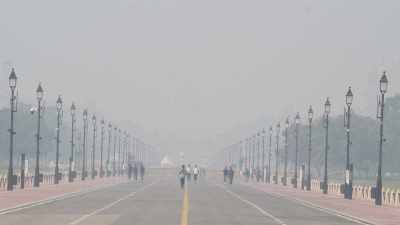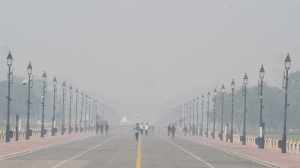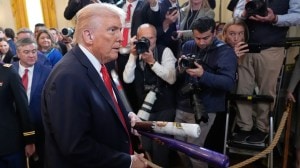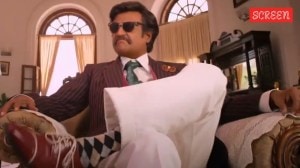Mr. India
HEARING him tell it, it’s easy to slot Masanori Fukuoka as one of those men whose lives are defined by a single passion. For Fukuoka is...

HEARING him tell it, it’s easy to slot Masanori Fukuoka as one of those men whose lives are defined by a single passion. For Fukuoka is one of the most dogged collectors of Indian contemporary art in the world, boasting of every gallery artist worth his canvas.
If you covet it, he has it: Akbar Padamsee, MF Husain, Ganesh Pyne, J Swaminathan, Ved Nayar, Manjit Bawa, Arpita Singh, Krishen Khanna, Ram Kumar. And of course, the biggest and most expensive of them all, Tyeb Mehta’s triptych Celebrations, which he picked up at a New York auction in 2002 for Rs 1.5 crore.
‘‘I ventured into Indian art in much the same manner as I came to India—without a guidebook,’’ says Fukuoka, 52. ‘‘I bought my first paintings, maybe 50 of them, in 1990. But I remember only some of them.’’
Chances are not too many of them were significant, because it was around the same time that certain galleries were passing off minor artists for major prices. Fukuoka’s previous experience in art was limited to South Asian pieces, and his sole adviser was his instinct.
By 1990, Fukuoka had made 25 trips to the land he first visited as a 22-year-old student of Buddhism at the University of Tokyo. ‘‘I had picked up some art in Singapore, and was wondering why I did not have any Indian artists even though I was here so often.’’
| I can’t look at a painting for more than two minutes, I don’t even like all the paintings I have |
The businessman in him—Fukuoka’s Glenbarra salmon factory in Himeji, Japan, rakes in $6 million a year—was also perturbed by the lack of parity in the pricing of Indian and American or European art.
‘‘It was that old demand-supply issue,’’ Fukuoka says cryptically, of the Indian art scene he discovered. ‘‘Someone had to do (the buying).’’
Coming just days after Akbar Padamsee’s Mirror Image sold at Christie’s for $186,000, his words have a ring of vindication. Does he really see himself as a messiah of Indian art?
His head begins shaking even before the question is complete. ‘‘It is all dependent on the economy. It happened in Europe, in America, in Japan, in China. Once people have houses, they have empty walls, and want art to hang on them. Now is the time for India.’’
Curiously though, none of Fukuoka’s massive art collection—he refuses to put a figure on it, though guesses hazard between 5,000 and 8,000—makes its way into his home. ‘‘I have only one painting in my home, and that is my younger daughter’s first oil-on-canvas, made when she was 10.’’
To live with a piece of art, Fukuoka acknowledges, demands something special of a man. ‘‘I can’t look at a painting for more than two minutes, I don’t even like all the paintings I have,’’ he says. ‘‘In fact, I think the man who says he finds peace by looking at a painting must be a very unhappy man.’’
|
FUKUOKA ON FUKUOKA
|
|
|
Favourite tipple Not wine, not whisky, it’s desi Old Monk |
The inevitable question follows. A long silence, while Fukuoka gazes pensively at the Ram Kumar abstract on the far wall. ‘‘I suppose that must be a very good question, but I have never thought about it. If I knew why I was buying (art), I wouldn’t be buying it.’’
The mystery, however, was potent enough to fuel a journey from indiscriminate buying to consummate connoisseurship (leading, most recently, to a Souza in Mumbai). Over the last five years, Fukuoka has built up a personal rapport with most of the artists in his portfolio—Jogen Chowdhury is a particular favourite—but more than that, he has honed a fine eye for the best in Indian art. And the best of his collection, maybe 100 paintings, hang in his Glenbarra gallery, cut away from the food factory after his original whale-meat business switched to salmon. But there aren’t too many takers for Indian art in this corner of Japan, famed only for its 14th century castle.
‘‘I once took my collection to Hiroshima. But most visitors came looking for confirmation of their India experience, the camels and the sand dunes,’’ Fukuoka smiles wryly.
That hasn’t put him off showing off his collection: Fukuoka is planning a group show of 10 artists with 10 works from each in India. Because prices will shoot up if he names them—this is, after all, the man who bought ‘‘three-to-four times the 28 Jogen paintings I needed for a book, so I could select the best’’—Fukuoka switches subjects. And ruins the easy one-man-one-passion categorisation.
‘‘Actually,’’ and his voice drops a couple of notches, ‘‘I’m more excited about going whitewater rafting in Ladakh. All these years, I only visited Mumbai, Kolkata, Delhi, the cities with airports and art galleries. Last year, for the first time, I went to Sikkim and Kerala. Tomorrow, I’m off to Darjeeling.’’
His only constant companion on these trips: His trusty Nikon D2X. The self-confessed ‘‘good photographer’’ likes taking back a bit of nature in his hand baggage. The artworks can come in cargo.






- 01
- 02
- 03
- 04
- 05

























